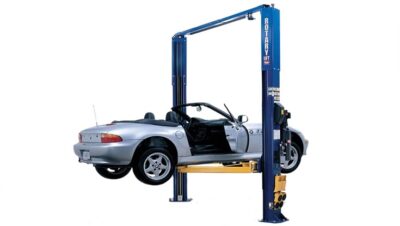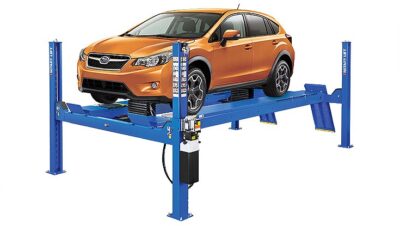Vehicle hoists
Vehicle hoists raise the whole off the ground so that technicians can easily work on the underside of the vehicle. When the vehicle is hoisted, technicians do not have to bend down or lie down during operation.
Vehicle hoists have several different designs. Come in a range of sizes and configurations to meet the particular needs of the workshop. The most common types of vehicle hoists in general use are single-post, two-post, and four-post hoists. Other types of hoists include scissor lifts, parallelogram lifts, and mobile or specialty lifts. The in-ground hoist is very compact and leaves free space around the vehicle but blocks access to the center under the vehicle.
Single-post hoist, scissor and parallelogram lift
Each vehicle hoist should have a mechanical locking device so that the vehicle hoist is secured at the desired height. This locking device prevents accidental lowering of the vehicle and keeps the vehicle in place even if the lifting mechanism fails. Never walk under a raised vehicle until the safety locking mechanism is activated.
Vehicle hoists are dimensioned for a specific weight and vehicle type and must never be used for purposes other than those recommended by the manufacturer. In particular, a vehicle that is heavier than the specified maximum capacity of the hoist should never be lifted. In most countries, some regulations require periodic inspection of the crane (usually for one year) and obtaining a certificate of use. Before using the hoist, it is necessary to check its load-bearing capacity and the validity of the use permit (certificate) on the plate.
Also, before lifting, check that the vehicle body is undamaged and compact. Damage, rust or any repairs to the bodywork during lifting can damage the vehicle and even be dangerous to you.
Check that the vehicles are too high or that they have roof racks, which can lead to damage to the roof structure during lifting.
Lift the vehicle with a crane to the appropriate work height. Lock the hoist before working under the vehicle.
Two-Post Hoist
Two-post hoists are most often used in car workshops. We have two types – symmetrical and asymmetrical. Symmetrical two-post hoists have paws of equal length so that the vehicle is placed symmetrically between the posts. This positioning places the pillars in the direction of the vehicle’s front doors, which makes it difficult to get in and out of the vehicle. Asymmetrical hoists have shorter arms in front of the posts than in the rear of the posts. This allows the vehicle to be positioned farther back on the hoist, allowing better access to the doors on the vehicle. Both types of two-post hoists allow technicians easy access to the lower part of the vehicle and the ability to remove wheels while the vehicle is raised.
Two-post hoist
Two-post hoists require careful positioning of the hoist arms so that they are below the appropriate lifting points on each side of the vehicle so that the weight of the vehicle is evenly distributed. The service information for the vehicle details where those lifting points are so that the vehicle can be raised without causing structural damage. Check if rubber pads are needed to protect the vehicle.
Four-Post Hoist
Using a four-post hoist is very easy. The vehicle was imported on two narrow wheel platforms, one on each side of the vehicle. The platforms are then raised, taking the vehicle with them. The underside of the vehicle is accessible to the technician. However, the wheels cannot be removed because the vehicle relies on hoist platforms over them. Another type of hoist must be used to remove the wheels from the vehicle.







